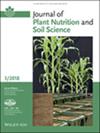Metabolites Released by Poaceae Roots Under Iron-Deficient Conditions
Abstract
Background
Strategy-II, as a response mechanism, is limited to grasses under Fe deficiency and is based on the secretion of phytosiderophores (PS) into the rhizosphere, in conjunction with the induction of a high-affinity system for Fe(III)-PS uptake. This strategy has a significant ecological impact and is essential for sustainable agriculture.
Aims
In this work, we studied the physiological and metabolic responses of Poa pratensis L., Lolium perenne L., and Festuca rubra L. when grown in nutrient solution under Fe deficiency.
Methods
After chlorosis appeared, we analyzed leaf pigment concentrations, biomass, and ferric chelate reductase (FCR) activity of root tips. We also screened the metabolites released by root exudates using liquid chromatography coupled to high-resolution mass spectrometry (LC–HRMS).
Results
Plants grown with low or no Fe availability had significantly lower fresh weight (FW) and leaf chlorophyll (Chl) but higher FCR activity as compared to control plants. The root exudates contain carboxylic acids, phenolic acids, polyphenols, and peptides, among others. An increase in carboxylic acid content was correlated with Fe chlorosis in all species studied. However, the specific compounds that were upregulated varied depending on the species. Root exudates contained several upregulated metabolites that were identified as small peptides and/or peptide derivates based on their spectral data and formulas that are compatible with small peptides and/or peptide derivatives.
Conclusions
These results, together with the metal binding/chelation properties of many peptides, highlight the release of these compounds and/or their derivatives as a response of grasses to increase the Fe bioavailability.

 求助内容:
求助内容: 应助结果提醒方式:
应助结果提醒方式:


